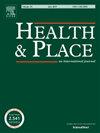大伦敦绿地中道路交通噪音暴露水平的不平等。
IF 4.1
2区 医学
Q1 PUBLIC, ENVIRONMENTAL & OCCUPATIONAL HEALTH
引用次数: 0
摘要
在住宅环境中接触道路交通噪音会对健康产生有害影响,包括烦恼、睡眠障碍、心脏代谢结果和心理健康。相反,接触自然的声音可以提高人类的认知能力,并有助于恢复压力。环境暴露研究表明,噪音暴露在城市之间的分布往往不公平,但与英国绿地噪音有关的证据仍然有限。本研究分析了大伦敦与住宅地址相关的绿地噪音水平的可变性和不平等。根据欧盟委员会噪声评估通用框架(CNOSSOS-EU) 2002/49/EC环境噪声指令中的方法和声衰减的平方反比定律,在2,532个绿地上模拟了白天和晚上主要道路和次要道路的噪声水平。通过模拟道路交通噪声估算,我们发现28%的绿地在白天和晚上超过了世界卫生组织的等效噪声指导标准。伦敦市中心的绿色空间的噪音水平更有可能超过世界卫生组织的噪音标准。基于距离的接近度分析表明,对于伦敦市中心的人口来说,离居民区最近的绿地更有可能具有高噪音水平。随着距离居住地点的距离增加,高绿地噪音水平的分布变得更加分散。然而,在不同的被剥夺群体之间没有观察到不平等梯度,除了最不贫困的社区,在5公里半径内的绿地区域内,他们的噪音水平要低2分贝。本文章由计算机程序翻译,如有差异,请以英文原文为准。
Inequalities in road traffic noise exposure levels in greenspaces in Greater London
Exposure to road traffic noise in residential settings has been associated with detrimental effects on health including annoyance, sleep disturbance, cardiometabolic outcomes, and mental health. Conversely, exposure to natural sounds improves cognitive performance and aids in stress recovery in humans. Environmental exposure studies have shown that the distribution of noise exposures is often not equitable across cities, but evidence related to noise in UK greenspaces remains limited. This study provides an analysis of noise variability and inequalities in noise levels for greenspaces in Greater London related to residential addresses. Noise levels from major and minor roads were modelled across 2,532 greenspaces for the daytime and evening period in accordance with the European Commission Common Framework for Noise Assessment (CNOSSOS-EU) methods from Environment Noise Directive 2002/49/EC and the inverse square law of sound attenuation. Using modelled road traffic noise estimates, we found that 28 % of greenspaces exceeded equivalent World Health Organization noise guideline levels during daytime and evening periods. Greenspaces in Central London were more likely to have noise levels that exceeded the WHO noise guidelines. Distance-based proximity analyses showed that for populations in Central London, greenspace areas nearest to residential addresses were more likely to feature high noise levels. As distance travelled from residential locations increased, the distribution of high greenspace noise levels became more dispersed. However, no inequality gradient was observed between different deprivation groups, except for the least deprived communities’, who experienced noise levels that were 2 dB lower within greenspace areas within a 5 km radius.
求助全文
通过发布文献求助,成功后即可免费获取论文全文。
去求助
来源期刊

Health & Place
PUBLIC, ENVIRONMENTAL & OCCUPATIONAL HEALTH-
CiteScore
7.70
自引率
6.20%
发文量
176
审稿时长
29 days
期刊介绍:
he journal is an interdisciplinary journal dedicated to the study of all aspects of health and health care in which place or location matters.
 求助内容:
求助内容: 应助结果提醒方式:
应助结果提醒方式:


